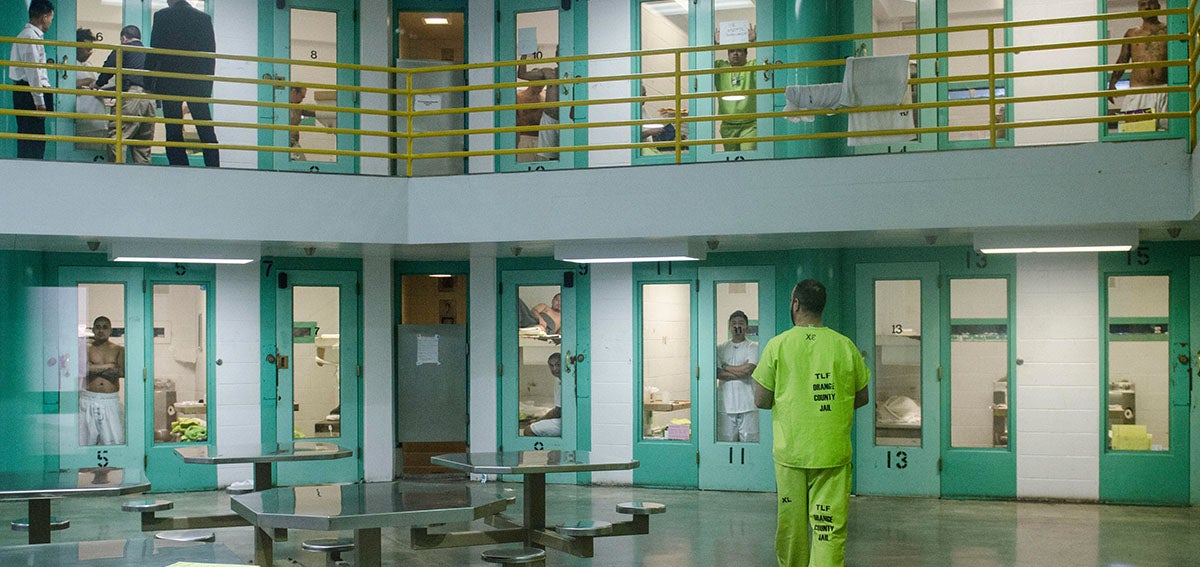
Many county correctional facilities throughout California are reducing their teeming populations to prevent large-scale COVID-19 outbreaks. The dorm rooms, dining halls, and recreation areas in many of these institutions are breeding grounds for spreading the virus, experts say.
People have been complaining for weeks that inmates don’t have hand sanitizer or equipment like masks to protect themselves and that cramped quarters make it impossible to practice social distancing, said Sonja Tonnesen-Casalegno of Root & Rebound, which runs a legal advice hotline for people incarcerated in California. An uncontrolled outbreak among jail populations would be impossible to contain within jailhouse walls. Correctional staff and other workers constantly enter and exit these facilities, and it is not hard to imagine the coronavirus being spread by them to surrounding communities.
A number of California’s 58 independent county jail systems have responded to the pandemic by releasing inmates. San Francisco has reduced its jail census by close to 40% this year. The reduced population allows the jail to keep detainees six feet apart, separate them into groups of eight to minimize infection risks, and quarantine new arrivals for 14 days, officials said. People over age 60 are housed in single cells. At least 12 other counties, including Los Angeles, Monterey, Santa Clara, and Tulare, have slashed their jailhouse populations by at least 20%, and Marin County reportedly cut its census by almost half, according to the nonprofit Vera Institute of Justice, which tracks county jail populations nationwide.
“Advocates have been saying for decades . . . that we’re one pandemic away from a disaster. Here we are. Here’s COVID-19.”
—Sharon Dolovich, Prison Law and Policy Program at UCLA
In California state prisons, despite more than a decade of efforts to reduce its population before the pandemic, the legacy of mass incarceration policies left the system chronically overcrowded, critics said. As of April 15, the state’s prisons were at 130% of capacity, with more than 118,000 inmates, according to the California Department of Corrections and Rehabilitation (CHCR) (PDF). The statewide head count has dropped by more than 6,000 since January (PDF) under orders from Governor Gavin Newsom to halt intakes and because officials have expedited the release of around 3,500 nonviolent offenders with 60 days or less left to serve. As of April 21, 131 state prisoners and 95 prison staff had tested positive for the novel coronavirus, according to CDCR.
Unlike with the state prison system, no single California entity tracks coronavirus or COVID-19 across all 58 county jail systems.
A Disaster Waiting to Happen
Many incarcerated people are elderly or have chronic health conditions. Jails and prisons tend to have limited capacity (PDF) to provide health care to seriously ill people.
“Advocates have been saying for decades that this is a disaster waiting to happen — that we’re one pandemic away from a disaster,” said Sharon Dolovich, a law professor and director of the Prison Law and Policy Program at UCLA. “Here we are. Here’s COVID-19.”
“We need [a prison and jail] population reduction immediately,” said UCSF professor Brie Williams, MD, MS, director of UCSF’s Amend program, which develops strategies for correctional facilities. “It’s going to require all hands on deck, including re-entry planners and coordinators, health care professionals, community advocates and social services, policymakers, and correctional leadership.” Amend has published detailed recommendations (PDF) for jails and prisons.
Thirty Percent Reduction
The population at Alameda County’s main Santa Rita Jail in Dublin has declined by 800 since March 1 — a decrease of more than 30%. Some inmates received court approval for early release or were allowed to skip custody without posting bail. Deputies and local police are citing low-level offenders instead of arresting them. Those measures haven’t stopped a spike in COVID-19 at Santa Rita, however, prompting a spat between the county public defender and the district attorney over whether to speed up early releases.
The smaller population allowed Santa Rita to split into four zones, said sheriff’s spokesman Sgt. Ray Kelly. One section is for healthy inmates, another is for those at high risk because of age or poor health, a third is for inmates potentially exposed to COVID-19, and a quarantine area is for anyone who tests positive.
“It gave us more flexibility, more room to reduce the pressure on the medical staff,” Kelly said. “They can be more responsive to COVID-19 and more attentive to people with health risks.” The department works with local organizations to ensure people who are homeless and are released early can find shelter, he said.
Ventura County has achieved more than a 30% decrease in jail population since February because early releases, closed courts, and modified detention criteria mean many fewer people are being booked. Ventura’s two jails were operating below capacity before the outbreak, said Capt. Mike Beckett of the county’s detention services administration. The combined population now is about 1,000, well below the capacity of 1,650. Ventura sheriff Bill Ayub has worked with local agencies to reduce arrests, responding to reports rather than proactively seeking evidence of crimes, Beckett said. Ventura jails separate detainees into isolated cohorts of eight people and have quarantine space available, he said. The county jails have not detected coronavirus among inmates, although a sheriff’s deputy tested positive. “I do feel like we’re way ahead of things,” Beckett said. “If it hits us, we’re ready, and we have plans.”
Some Jail Populations Not Falling
Many California counties have not reported population decreases, according to Vera Institute data. Through March, Solano County deputies were rounding up people recently freed from other county jails and transporting them to their own jail, the San Francisco Chronicle reported. Tehama County’s jail population increased 11% after the coronavirus outbreak began, the Vera Institute reported, although it’s now up by only 3%. Fresno, Riverside, and San Bernardino counties initially did not change their local jail policies or release inmates early, according to CalMatters.
Even jail systems that are actively pursuing population reduction may be doing too little too late, according to some experts and advocates. According to data from the Prison Policy Initiative, incarceration rates in California and nationwide are high compared to other countries and have long caused overcrowding, they say. Problems such as understaffing and inadequate hygiene and medical care are difficult to resolve overnight, some experts argue.
What Happens When People Are Released?
Organizations that provide reentry services say the recent releases are having a significant impact. “The rate at which they’re coming out is overwhelming current resources in the community,” said Shira Shavit, MD, executive director of the San Francisco–based Transitions Clinic Network, which supports programs providing medical care to people exiting the criminal justice system.
Clinics struggle to connect with newly released people, so the network set up a hotline to help them obtain medical care, phones, forms of identification, and other basic needs for survival on the outside, Shavit said. She worries that these problems will force many newly released people to resort to emergency rooms, overwhelming an already-taxed health care system.
Many incarcerated people who are released for their own protection from COVID-19 struggle to stay healthy once they’re back in the community, said Shavit, whose Transitions Clinic Network includes 21 programs at California clinics, as well as dozens of others around the country. Six sites are in Los Angeles County, where a large number of early releases have occurred.
Often people with chronic conditions are released from jail with only a week’s supply of medications and sometimes only a prescription, Shavit said. They usually get a 30-day supply, but that may not be enough because many clinics are limiting hours or postponing appointments. Many newly released people don’t have a phone or a computer to take advantage of telehealth opportunities. They might be struggling to find housing and employment. Although people released early typically are entitled to Medi-Cal insurance, they must activate that coverage by phone or in person, and that’s difficult without phones, Shavit said.
Investing in Organizations to Strengthen Services
Community organizations assisting with reentry also need help, said Tonnesen-Casalegno. Many are straining to meet demands for shelter and other services as more people are released. “The biggest need right now is for the government to [invest in] organizations that are on the ground providing services to be able to beef them up,” she said.
If California’s efforts to address the crisis facing jails and prisons are done right, they could have nationwide influence. “No one state can address this problem on their own, so it really does require the input of corrections leaders throughout the country, health care professionals on the front lines, and correctional staffs,” she said.
Still, the Golden State plays a special role, she said. “California has an enormous system, so lessons learned and approaches developed in California have extraordinary relevance to the rest of the nation.”
Authors & Contributors

Claudia Boyd-Barrett
Claudia Boyd-Barrett is a longtime journalist based in Southern California. She writes regularly about health and social inequities. Her stories have appeared in the Los Angeles Times, San Francisco Chronicle, San Diego Union-Tribune, and California Health Report, among others.
Boyd-Barrett is a two-time USC Annenberg Center for Health Journalism fellow and a former Inter American Press Association fellow.


